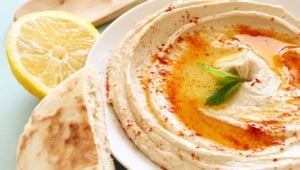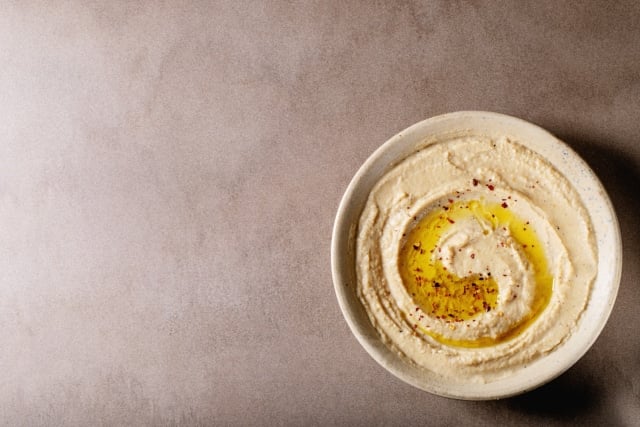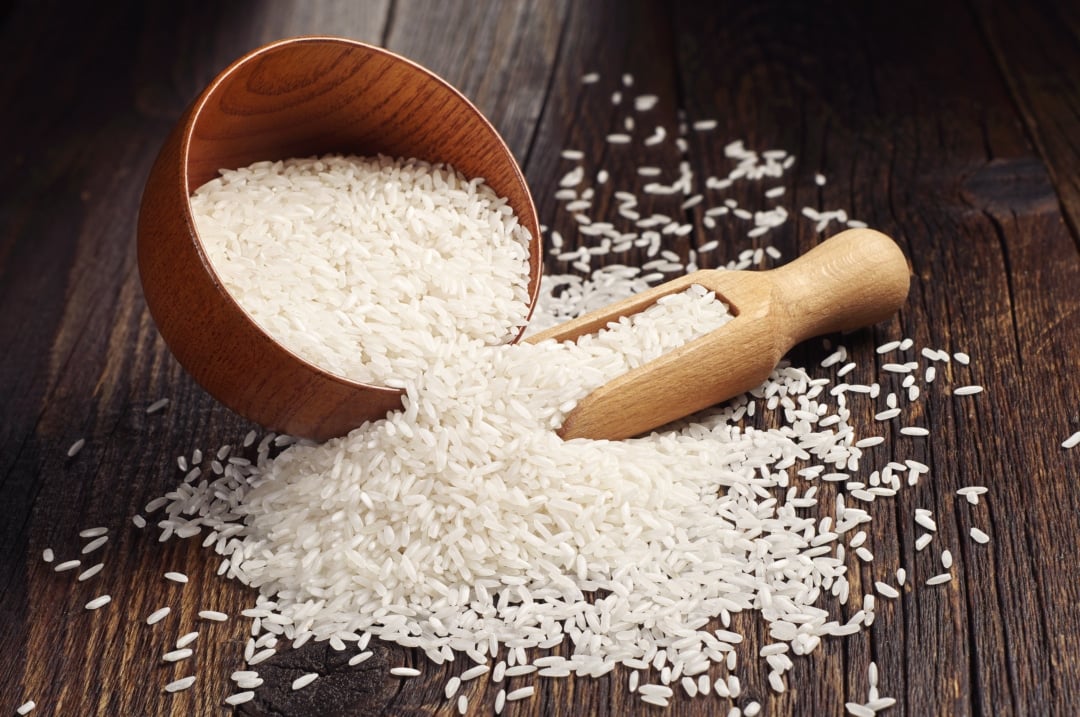9 Health Benefits of Hummus & 6 Tips and Recipes

You may have eaten hummus before, but do you know anything about its origin or nutritional value? Well, you won’t be in the dark for long. Today, we come to you with a comprehensive hummus crash course.
Despite being a simple dish, hummus has a massive cultural influence. Over the years, it has brought people together to celebrate their love for it.
Despite that unique legacy, you’d be surprised to see how little people know about hummus’s benefits and rich history. We’re here to change that.
In this guide, we’ll cover everything from the ingredients of hummus to its nutritional benefits and more. Let’s dive right into it.
What Is Hummus Made Of?

What Is Hummus Made Of?
There isn’t a definitive answer to that question, as it depends on where you eat it. However, the classic Middle Eastern recipe includes a chickpea puree, tahini (sesame paste), and lemon. It’s also become a tradition to add garlic and olive oil.
As you can see, the dish uses basic everyday ingredients, and that’s what makes it versatile. People can change the recipe however they want to match their palate.
The Origin of Hummus

The Origin of Hummus
You may have come across hummus or even tried it several times. Have you ever wondered where it came from, though? Who came up with such a simple yet flexible idea?
Unfortunately, the answer isn’t simple, as various countries have influenced the making and presentation of that dish over the years. So now it’s hard to tell which region is the originator without starting a heated historical debate.
It doesn’t help that hummus uses ingredients that have been around for thousands of years and come from all over the world. For example, early records of chickpeas indicate that it’s a Turkish plant. The sesame used to make tahini, on the other hand, is native to Asia and East Africa.
It’s also worth noting that documentation wasn’t as easy back then as it is today, which means hummus may have existed before it was first documented in cookbooks.
That doesn’t mean there aren’t any theories, though. Let’s take a look at some of them.
Biblical Origin

Biblical Origin
Hummus having a biblical root is one of the hottest takes on the origin of that dish. Many Jewish people believe that hummus was mentioned in the Hebrew Bible 3500 years ago.
In the Book of Ruth, when Boaz meets Ruth for the first time, he says: “Come hither, and eat of the bread, and dip thy morsel in the hometz.”
Yes, it’s believed that the word “hometz” is an early variation of “hummus,” since both words sound similar. However, modern readings of the Hebrew Bible debunk this theory, as “hometz” is interpreted as “vinegar.”
The idea of Boaz inviting Ruth to dip her bread in vinegar seems odd to most people, though. Alas, that only indicates that this theory stands on uneven ground. That’s why food historians didn’t confirm its accuracy.
Egyptian Origin

Egyptian Origin
It’s no wonder Egypt takes place on this list. After all, Egyptians were famous for being pioneers in engineering, architecture, and agriculture. What would’ve prevented them from inventing such a genius dish?
A few cookbooks from 13th-century Cairo describe a recipe that resembles hummus. It’s made with chickpea puree, lemon, vinegar, and other herbs. It’s the same as the classic hummus recipe, right? Well, not really.
Many historians don’t believe this recipe is the origin of hummus because it doesn’t include tahini. Can we consider it a hummus recipe without tahini? It’s one of the main ingredients of the modern version, after all.
You can argue that it’s just a different variation of the same dish. So, is it still valid? Unfortunately, that theory doesn’t stand because the historical connection isn’t strong enough.
Syrian Origin

Syrian Origin
The Syrian origin argument might have the most compelling evidence on this list. First, food historians who think hummus is Syrian based their hypothesis on the representation of the dish.
The classic way to serve hummus throughout the Middle East was to put it in a deep red clay bowl. It would be spread around the edges of the bowl, creating a hollow space in the middle.
The idea behind this representation is to make dipping the bread in the hummus easier. Food historian Charles Perry believes the practice of spreading hummus throughout the edges of the bowl indicates that it comes from an urban environment; Syria.
We know what you’re thinking, though: “That’s not a compelling argument.” You’re right. So maybe the following discovery might change your mind.
Evidence proving hummus’s Syrian roots rose to the surface only a few months ago. Searching for cookbooks that were lost during the Mongol invasion of Baghdad, journalist Mahmoud Habboush came across a 13th-century Syrian cookbook.
Can you guess what Habboush found in that book? The oldest record of a classic hummus recipe we have today.
Unlike the Egyptian book, this one described a hummus dip with chickpeas, tahini, and lemon. So, that might give a glimpse of why many historians believe hummus is a Syrian recipe.
It’s worth noting that sentimentality takes part in the debate. So, just because we presented compelling evidence doesn’t mean people will believe it.
Interesting Facts About Hummus

Interesting Facts About Hummus
Now that you have a solid background, we want to offer you a few fun facts about hummus that you may not know.
You Can Use Chickpeas to Make Coffee

You Can Use Chickpeas to Make Coffee
That may come as a surprise to most caffeine addicts, but chickpeas, the base of hummus, can be an effective alternative to coffee.
The idea came to life during WWI when resources were limited. People decided to use chickpeas instead of coffee beans to make coffee, and the tradition lived on to this day.
The chickpeas are roasted until brown and ground into fine powder.
The process of making chickpea coffee is the same as regular coffee. Some people say it tastes the same. Others say it’s different. We’ll let you be the judge of that.
Hummus Is Aphrodisiac

Hummus Is Aphrodisiac
Samantha Jones wasn’t lying when she said that hummus has natural estrogen in Sex and the City. If you’ve paid attention in high school, you know that high estrogen levels can increase women’s sexual drive.
Hummus’s effects aren’t exclusive to women, though. The chickpeas contain vitamin B6, which, besides regulating the homocysteine circulation in your body, can also boost men’s sexual drive.
Chickpeas aren’t the only ingredient contributing to that boost, as olive oil and garlic have a similar effect.
There’s an International Hummus Day

There’s an International Hummus Day
It all started when Ben Lang, a tech entrepreneur, wanted to create a day when people could come together and celebrate their love for hummus.
While it started as a joke, many countries now celebrate May 13th by making, buying, and eating hummus together.
Is Hummus Keto and Gluten-Free?

Is Hummus Keto and Gluten-Free?
Those are two interesting questions that require us to delve into the nature of hummus to answer. So, let’s not waste any time.
Is Hummus Suitable for a Keto Diet?

Is Hummus Suitable for a Keto Diet?
Most of the ingredients of hummus are keto-friendly. The only troublesome component would be the chickpeas.
You see, anyone following a keto diet needs to consume less than 50 grams of carbs (25 grams of net carbs).
Two tbsp of hummus contains 6 grams of carbs (4 grams of net carbs). So it can be a viable addition to your diet if you limit your intake to a couple of tablespoons a day.
Is Hummus Gluten-Free?

Is Hummus Gluten-Free?
The classic hummus recipe is usually gluten-free, as it doesn’t include wheat, barley, or rye. Commercial hummus is a different story, though.
Manufacturers can add gluten to their hummus recipe to thicken it, so read the label before you buy it.
Nutritional Facts About Hummus

Nutritional Facts About Hummus
A single serving of hummus (30 gram) includes the following:
| Nutritions | 30 grams of hummus |
|---|---|
| Fiber | 2g |
| Fat | 5g |
| Carbs | 5g |
| Calories | 71 |
| Protein | 2g |
| Iron | 2% of the daily value |
| Magnesium | 3% of the daily value |
| Copper | 7% of the daily value |
| Zinc | 2% of the daily value |
| Manganese | 7% of the daily value |
As you can see, hummus contains key nutrients that people need from their daily food intake. Whether you’re a vegan, vegetarian, or a meat lover, hummus is an excellent addition to your diet.
Health Benefits of Eating Hummus: Why It Is So Good for You

Health Benefits of Eating Hummus: Why It Is So Good for You
We know you don’t care about numbers and percentages, so it’s time to dive into the potential health benefits of this dish.
Improves Digestive Health

Improves Digestive Health
The dietary fiber in hummus keeps the digestive system working like a well-oiled machine. It softens the stools in your body to make their release easier.
One study shows that consuming 200g of chickpeas for 3 weeks helps feed beneficial bacteria. Besides easing the digestion process, this bacteria prevents infections and is an excellent source of vitamin B.
It can also turn some of the fiber content in hummus into butyrate. This short-chain fatty acid provides colon cells with 70 percent of the energy they need to allow the digestive system to work properly. Studies have also shown that butyrate can prevent colon cancer.
Reduces the Risk of Heart Disease

Reduces the Risk of Heart Disease
With millions of people falling victim every year, cardiovascular diseases have become the leading cause of death worldwide.
Luckily, hummus is known to reduce the risk of heart disease. We can see its effectiveness in a 5-week study where researchers divided patients into two groups.
One consumed extra wheat as part of their diet, while the other ate chickpeas.
At the end of the study, they noticed that the chickpeas group showed better blood cholesterol levels than the wheat group. How much better? They had 4.6 percent lower LDL cholesterol levels, which reduces the risk of having heart problems.
One study showed that a 5-gram daily intake of olive oil, one of the main hummus ingredients, reduces the risk of heart disease.
Reduces Chronic Inflammation

Reduces Chronic Inflammation
You probably don’t think of sunshine and rainbows when you hear the word inflammation, but it’s an inherently harmless process. Ultimately, it’s a defense mechanism that allows your body to protect itself from illnesses and infections.
However, it can cause serious health issues if it lasts longer than necessary. That’s what health professionals call chronic inflammation.
As we’ve already established, homemade hummus usually includes olive oil, which, besides lowering the risks of cardiovascular diseases, contains powerful antioxidants that reduce chronic inflammation. That’s especially true if your hummus recipe includes virgin olive oil.
The oleocanthal inside it has anti-inflammatory characteristics similar to the ones in famous anti-inflammatory meds. The sesame seeds in hummus can also reduce the inflammatory effects of interleukin-6 lymphokine.
Regulates Sugar Levels in Blood

Regulates Sugar Levels in Blood
If you don’t know, the glycemic index (GI) indicates how quickly food can raise your blood sugar.
Usually, your body absorbs food with a high glycemic index (GI) quickly, causing a sudden rise and fall in blood sugar levels.
In contrast, it absorbs food with low GI slowly, resulting in a gradual, balanced rise and fall in blood sugar levels. Can you guess which category hummus falls under? Yes, the chickpeas in it have a low glycemic index.
They’re an excellent source of fiber, protein, and resistant starch. These ingredients help your body digest carbs slowly, keeping your blood sugar levels safe and regulated. The healthy fats in hummus can also help your body release sugar into the blood at a more steady pace.
Promotes Healthy Weight Loss

Promotes Healthy Weight Loss
If you’re struggling with weight management, hummus might be your new best friend. While it’s not a magical solution, several studies have proven it can help you lose weight.
One study showed that people who consume hummus or chickpeas regularly are 53 percent less likely to experience obesity. Not only did they have shorter waist circumference, but they also had lower body mass.
So you get full by eating less, resulting in better weight management. Hummus can also reduce the levels of certain hunger hormones, like ghrelin. You won’t have as much of an appetite, making it easier to lose weight.
Helps With Bone Growth

Helps With Bone Growth
Milk isn’t the only calcium-rich ingredient you can consume. Just a few tablespoons of hummus contain 2g of calcium.
Most people know that calcium is a necessary component for healthy bone growth. It also allows your body to function properly, from circulating blood to releasing hormones.
Safe for Nut and Dairy Allergies

Safe for Nut and Dairy Allergies
Although chickpeas look like small peanuts, hummus is actually free of nuts.
It’s also safe for lactose intolerant people, as it’s dairy-free. But that doesn’t mean you should let your guard down.
If you have store-bought hummus, check the ingredient list before eating it, as manufacturers can sometimes add extra ingredients.
Helps Resist Anemia

Helps Resist Anemia
Anemia occurs when your body doesn’t produce enough red blood cells. It comes in different forms, the most common of which is iron anemia. That’s where the lack of iron is the primary cause of anemia.
As we’ve already established, hummus is rich in iron. Additionally, the lemon in the classic recipe helps your body absorb that iron.
So, adding hummus to your diet is an effective way to produce enough red blood cells and resist iron anemia.
Enhances Your Mood

Enhances Your Mood
Hummus contains multiple amino acids, including Tyrosine and tryptophan. These contribute to the production of serotonin and dopamine, which give you a sense of pleasure and happiness.
Potential Risks of Hummus

Potential Risks of Hummus
You probably think that hummus is a magical dish that everyone should consume. While it offers various health benefits, it also has its risks.
High in Sodium
We know sodium is a healthy nutrient. However, if you consume too much sodium-rich hummus, you risk raising your blood pressure. That can potentially cause heart problems.
Can Cause Digestive Problems

Can Cause Digestive Problems
Yes, we know we dedicated an entire section to the digestive benefits of hummus.
However, that might lead some people to think: “The more hummus I eat, the smoother my digestive system works.” Unfortunately, that’s a recipe for disaster.
High fiber intake can cause stomach distress. On that account, you should limit your hummus consumption to 2-4 tbsp a day, and you’ll be fine.
Is Hummus in Pregnancy Good for You?

Is Hummus in Pregnancy Good for You?
Yes, hummus is one of the healthiest foods you can eat when you’re pregnant, as it includes all the nutrients you need.
Not only does the fiber content help with constipation, but vitamin E can also protect your body against free radicals.
It’s also worth noting that your blood volume increases during pregnancy. So, you need to produce more red blood cells, which the iron in hummus can help with. Rich in calcium, hummus can also help your baby grow strong bones.
Pregnant women have a high chance of developing magnesium deficiency. However, hummus can provide them with the necessary magnesium intake, allowing the baby to develop properly in the womb.
Can Dogs and Cats Eat Hummus?

Can Dogs and Cats Eat Hummus?
While chickpeas and tahini are the base of hummus, lemon, and garlic make the dish what it is.
Unfortunately, these ingredients aren’t safe for cats and dogs. That’s especially true for garlic, as it’s toxic for both.
It can cause anemia in dogs and damage cats’ red blood cells. Lemon can also cause stomach issues for dogs and skin irritation for cats.
Simple Recipe for Homemade Hummus

Simple Recipe for Homemade Hummus
You’ve probably formed a vague idea about how to make hummus. We’ve mentioned the ingredients multiple times. So, do you just randomly put them together and be done with it? The answer is now; there’s more to it than that.
Chickpeas
The first thing you want to start with is the chickpeas. Store-bought chickpeas (garbanzo beans) will do the trick. We recommend removing the skin for a smoother texture.
Tahini

Tahini
Since it’s just a sesame seed paste, you can make tahini by adding 1 cup of sesame seeds to a saucepan over medium heat. Make sure to stir constantly. After 3-5 minutes, they should develop a light color.
Let them rest for a few minutes, then drop them in a food processor. Mix the seeds until they form a crumbly paste.
Add 2-4 tbsp of vegetable oil, then continue processing. Once your mixture smoothens, add a pinch of salt (optional) and mix it until homogeneous.
Putting Everything Together

Putting Everything Together
Once your tahini is ready, keep ¼ cup of it in the processor and add ¼ cup of lemon juice. Mix them for one minute. Then, add one clove of chopped garlic, 2 tbsp of extra virgin olive oil, ½ tsp of cumin, and a pinch of salt.
Add a can of chickpeas in two patches while processing the mixture between each addition, and there you have it.
Delicious Recipe Ideas With Hummus

Delicious Recipe Ideas With Hummus
Now that you know how to make the basic hummus recipe, let’s spice things up a bit, shall we?
Hummus Bowl

Hummus Bowl
The hummus bowl isn’t a ground-breaking invention by any means, but it has taken the presentation of hummus to a new level. While it’s called a hummus bowl, it depends on other ingredients to look appealing.
You start preparing the bowl by adding baby spinach and quinoa. Add a few tablespoons of hummus beside them, then put chopped tomatoes, cucumbers, and onions.
You can arrange the different elements of that dish in whatever way you think is pleasing.
Hummus Sandwich

Hummus Sandwich
Yes, hummus can be more than just a dip. This recipe is convenient because you can use any leftover vegetables in your fridge.
We’ll show our favorite combo, though. Start with a layer of cucumber, then top it with hummus.
Add cheese (whichever type you enjoy), tomatoes, red onions, then another layer of hummus, and enjoy.
Roasted Tomato Hummus

Roasted Tomato Hummus
Preheat your oven to 400℉. Then, put three large tomatoes on a rimmed baking sheet, brush them with olive oil, season with salt, and roast them for 25 minutes.
Put your tomatoes in a food process, then add two cloves of minced garlic and ¼ cup of basil. Mix them together until homogenous.
Add a 15-ounce can of chickpeas, ½ cup of extra virgin olive oil, two tablespoons of lemon, and a pinch of salt.
Process your mixture until it becomes smooth and serve it with fresh basil and olive oil.
Tips for Using Hummus

Tips for Using Hummus
You know almost everything about hummus at this point. However, we want to end this post with a few tips for using it effectively.
Freeze Your Hummus
You don’t have to eat the entire hummus patch when you make it/buy it. You can save it for other meals. Whether it’s homemade or store-bought, hummus contains preservatives that help it freeze and thaw well. You can keep it in the freezer for about four months.
You Can Use It as Icing

You Can Use It as Icing
Yes, you heard us. We’ve reached the point where people are making dessert hummus now. The idea is to make the same base, chickpeas, and tahini, but add sweet ingredients instead of garlic and olive oil.
These ingredients could be anything: Vanilla extract, chocolate, honey, or peppermint oil. So you can add sweet hummus to cookies and cupcakes if you want.
- Tomato Juice. Health Benefits + Tips.
- Asparagus. Benefits for Your Health.
- Mango. Benefits and Side Effects.
- Peanuts. Health Benefits & Tips and Hacks.
- Dark Chocolate. Health Benefits and Tips.





